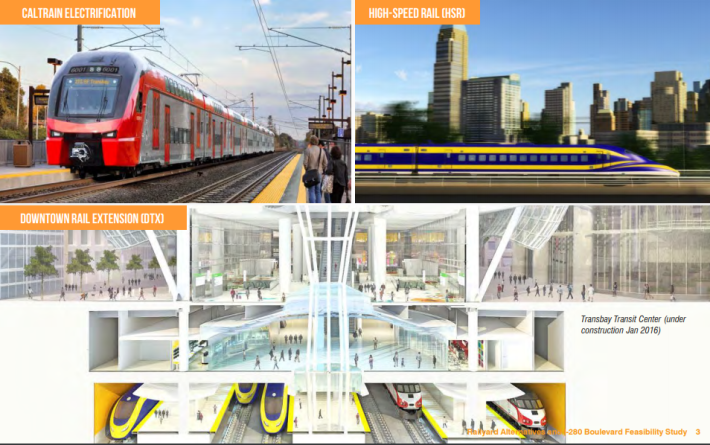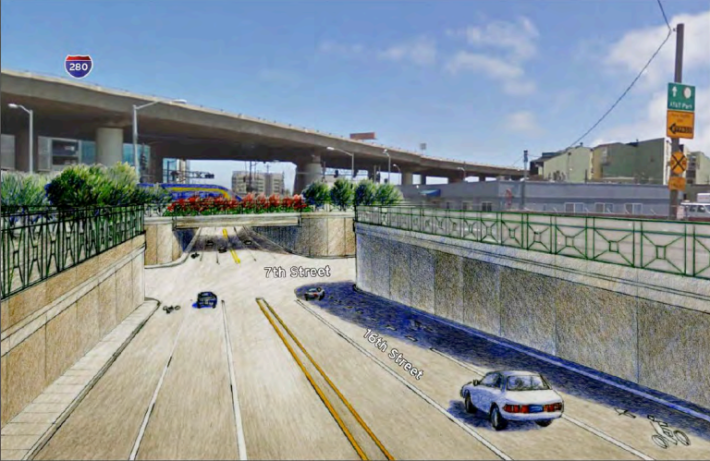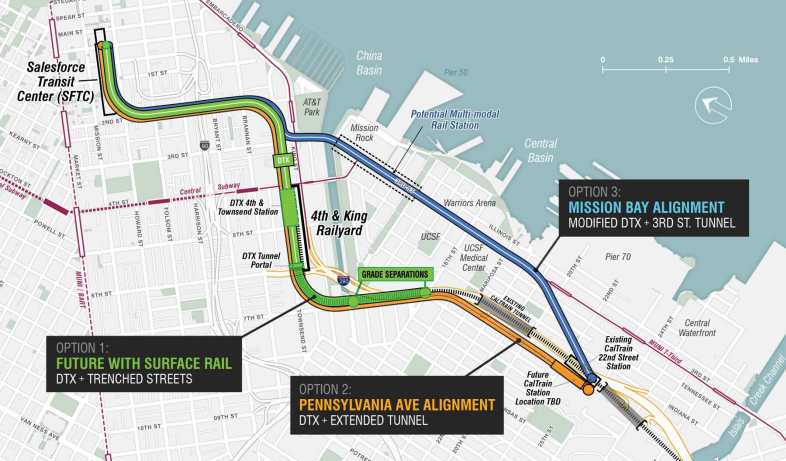Note: Metropolitan Shuttle, a leader in bus shuttle rentals, regularly sponsors coverage on Streetsblog San Francisco and Streetsblog Los Angeles. Unless noted in the story, Metropolitan Shuttle is not consulted for the content or editorial direction of the sponsored content.
San Francisco's Downtown Extension (DTX) project, to get Caltrain and future High-speed Rail into the Transbay Transit Center, may finally be back in motion.
SF Planning, with the support of other city and county agencies, has completed a supplemental study of the DTX project alignments. Dubbed the "Rail Alignment and Benefits Study (RAB)," it helps narrow down the best way to get the trains from the current terminus at King Street Station to Transbay. City and county staff are recommending the project follow the original DTX alignment, approved 16 years ago, but with the tunnel extended under Pennsylvania Avenue. The city unveiled the recommendations during a presentation yesterday evening at the San Francisco War Memorial Performing Arts Center across from City Hall.
This supplemental plan should be cleared by the Feds this summer or Fall, explained Susan Gygi, an engineer who worked on the proposal.
This should finally put one of the alignments, the Mission Bay route, to rest. As reported previously, this supplemental study was done in part to look for ways to eliminate the remaining grade crossings on the Caltrain alignment through San Francisco (more on that below). The Mission Bay alignment would have run in a tunnel under Muni's T-Third line, where utilities have already been cleared, making a tunnel simpler to build. But some felt it was only done with the hopes of adding a station in Mission Bay, to support and anchor real estate developments there.

Whatever the reason, many remain perturbed that this supplement added so many years to the project. Editorials in this publication and others have criticized the delays and bemoaned the fact that the Transbay Transit Center will open as a very expensive bus stop or a "Grand Central Station of the West" without any trains. "It's frustrating that it's taken as long as it has to get where we are now," said Peter Straus of the San Francisco Transit Riders, who came to hear the presentation. "But they've come up with a viable solution and we want the city to buy into it and move it ahead as fast as we can."
The DTX "... is a 100-year decision," said SF Planning Director John Rahaim. He likened it to when New Yorkers figured out the configuration for Grand Central Station's approach tracks under Park Avenue. "They covered over the tracks on Park Avenue 90 years ago.... it's important that we get this right."

SF Planning studied two basic supplemental alignments, as seen in the lead image. The Mission Bay alignment was rejected by staff, said Rahaim, because it scored weakest on a cost-per-rider analysis. According to the study, the Mission Bay alignment (the blue line on the map in the lead image) would cost $9.3 billion and would not be completed until 2031. The "surface alignment" (the green line), would follow the original DTX proposals to build a tunnel from near the current King Street station and travel underground to the Transbay Terminal basement train box, but retained Caltrain's current surface alignment south of King Street Station. It would cost $5.1 billion and get completed by 2026.
City and County planning staff united behind the so-called Pennsylvania Avenue alignment, which is similar to the "surface alignment" but has a much longer tunnel to eliminate grade crossings in San Francisco. If the plan is approved and the city moves forward, construction on this option would be completed in 2027 and would cost around $6 billion. The justification for the extra tunneling and cost? "It was decided that leaving grade crossings at 16th Street and Mission Bay Drive was unworkable, as far back as 2012 and even earlier," explained Gygi in a follow-up call. Gygi said that given the additional train volumes, crossing gates would be lowered for roughly a third of every hour, a serious problem for ambulances headed to UCSF Medical Center.
The idea of trenching the street was also nicked, because, as shown in the graphic below, it would ruin the streetscape:

Gygi likened the undercrossing idea seen above to the environment around Geary and Masonic and Geary and Fillmore, although she added it would be double the depth. That's why in the supplemental study they decided it would be worth the extra costs just to leave the streets at surface level, and instead extend the train tunnel.
The good news, she explained, is a train tunnel under Pennsylvania Avenue could be built in phases. They could build the tunnel envisioned in the "surface rail" plan by 2026 and start running trains into Transbay. The Pennsylvania Avenue tunnel would be completed a year later. It would take "a couple of weekends" to build the crossovers and start running trains all the way in a tunnel, explained Gygi. At that point the remaining surface tracks would be removed.
All the proposed alignments scored well for a future Transbay connection that would allow Caltrain and HSR to continue through a new tunnel from Transbay to Oakland and points farther east. When that would be built is still anybody's guess. The study is also looking at ways to construct a turnback loop so trains can run through the Transbay Transit Center as fast as possible.
Whatever the individual reservations, most in the audience expressed enthusiasm for finally getting the DTX project moving again. "I'm really eager for San Francisco to solidify around a plan so the region can move this forward," said Ratna Amin, Transportation Policy Director for SPUR.
Still, "The goal isn't to finish the study," quipped Straus, "it's to get the damn trains running."
For more information, the full study is available online.






